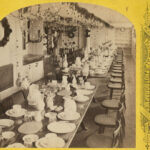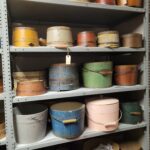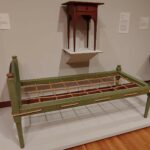

Following the Rules
For about one hundred years, the Canterbury Shakers made their own rulers. Fashioned of planed wood and incised with rules—the markings along the edge—a ruler allowed for efficient and accurate recording and transfer of information.

A Mess of Thanks-Giving
For every meal the Shakers gave thanks. When you visit the dining room in the Dwelling House, you see two versions of the space: the older taken from an 1880s stereograph view, the newer reflecting Shaker practice in the 1940s onward. The Shakers ate in silence, with dishes of food placed between four people so that no one need speak to ask anyone to pass a dish.

Pails in Comparison
A visit to Canterbury Shaker Village’s collection storage means we are going to learn something new.
Such was the case (Case! Collections pun!) when we came across shelves of wooden containers.

Vermin and Verdigris
With all that we know about the Shakers’ waking hours of work and worship, it’s time to ask how they slept. Did a day of physical labor and mental focus make for a restful night’s slumber? Did the more devout labor nightly about the state of their souls?
Handwriting on the Walls—and on the Furniture, too!
Remember the weekend of the Great Freeze in early February? Any great change in temperature and humidity results in possible problems with plumbing pipes—and for Canterbury Shaker Village’s unparalleled historic collections and structures. The Great Freeze required the Great Inspection of storage spaces, attics, basements, and cellars.

Shaker Pie is Rational: Some Thoughts on Pi Day 2023
Pie unites because it is so divisible. Unlike pi, pie was rational to Shakers who shared fairly at the dining table. How the Canterbury Shakers conceived of themselves was found not in distinctive foods but rather in their communal foodways: soups, meats, and vegetables were dished out from shared platters and bowls.

Following the Rules
For about one hundred years, the Canterbury Shakers made their own rulers. Fashioned of planed wood and incised with rules—the markings along the edge—a ruler allowed for efficient and accurate recording and transfer of information.

A Mess of Thanks-Giving
For every meal the Shakers gave thanks. When you visit the dining room in the Dwelling House, you see two versions of the space: the older taken from an 1880s stereograph view, the newer reflecting Shaker practice in the 1940s onward. The Shakers ate in silence, with dishes of food placed between four people so that no one need speak to ask anyone to pass a dish.

Pails in Comparison
A visit to Canterbury Shaker Village’s collection storage means we are going to learn something new.
Such was the case (Case! Collections pun!) when we came across shelves of wooden containers.

Vermin and Verdigris
With all that we know about the Shakers’ waking hours of work and worship, it’s time to ask how they slept. Did a day of physical labor and mental focus make for a restful night’s slumber? Did the more devout labor nightly about the state of their souls?
Handwriting on the Walls—and on the Furniture, too!
Remember the weekend of the Great Freeze in early February? Any great change in temperature and humidity results in possible problems with plumbing pipes—and for Canterbury Shaker Village’s unparalleled historic collections and structures. The Great Freeze required the Great Inspection of storage spaces, attics, basements, and cellars.

Shaker Pie is Rational: Some Thoughts on Pi Day 2023
Pie unites because it is so divisible. Unlike pi, pie was rational to Shakers who shared fairly at the dining table. How the Canterbury Shakers conceived of themselves was found not in distinctive foods but rather in their communal foodways: soups, meats, and vegetables were dished out from shared platters and bowls.




